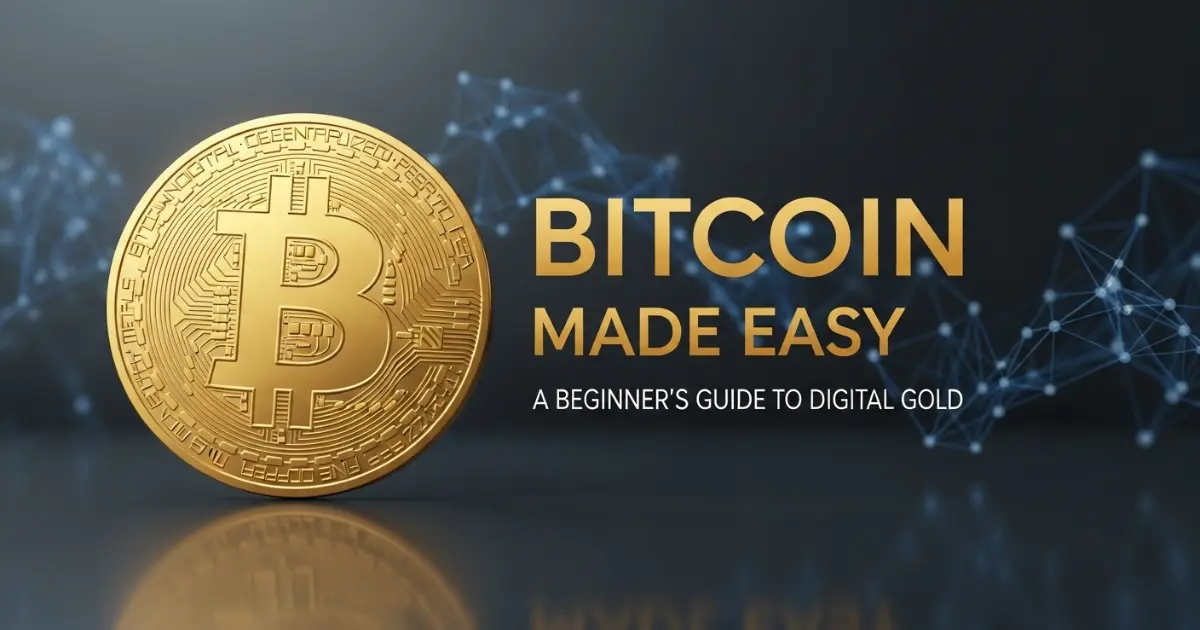
The cryptocurrency Bitcoin is often called “digital gold,” and for good reason. It’s the first decentralized cryptocurrency, created in 2009 by someone (or a group) using the pseudonym Satoshi Nakamoto.
What that means is: instead of being issued by a government or bank, Bitcoin is generated, verified and transferred over a worldwide network of computers. It’s special because no single entity controls it, and its supply is capped (more on that later). In this article we’ll walk you through what Bitcoin is, how it works, why people use it, how you can buy or hold it, and what the risks are—all in friendly, easy-to-understand language.
Bitcoin Made Easy: How Bitcoin Works
Bitcoin’s network fundamentals
At its core, Bitcoin runs on a peer-to-peer network. Transactions happen between users directly, without the need for a bank or intermediary.
Each transaction is recorded on a public ledger called the blockchain. This ledger is maintained by “miners” who verify transactions and secure the network through a process called Proof of Work. Because of this design, Bitcoin has key features: decentralisation, transparency, and scarcity.
Scarcity & digital gold analogy
One of the reasons Bitcoin gets compared to gold is because there will only ever be 21 million bitcoins. That means unlike many national currencies, which can be printed more, Bitcoin’s supply is limited. This scarcity underpins the term “digital gold.”
As mining continues and fewer new coins are issued over time (via events known as “halvings”), the argument goes that Bitcoin may retain value better than currencies that inflate.
Transactions and security
When you send Bitcoin, the transaction is broadcast to the network, validated by miners, and then included in a block, which gets added to the blockchain. The cryptography and distributed nature make it very hard to forge or tamper with.
However, security isn’t automatic—you as a user still must protect your wallet keys and follow safe practices.
Bitcoin Made Easy: Why People Use It
Store of value & hedge
Many see Bitcoin as a store of value—something you hold rather than spend immediately. Because of its scarcity and decentralised nature, it’s viewed by some as a hedge against inflation or currency devaluation.
Alternative payments
Bitcoin can also be used to send value across borders quickly and without traditional banks, which is useful for remittances or in regions with limited banking infrastructure. One example: residents in Kenya’s Kibera slum using Bitcoin payments as part of a fintech initiative.
Innovation & decentralised systems
Bitcoin sparked the blockchain era. Its technology paved the way for many other digital assets, smart contracts, and decentralised finance. Understanding Bitcoin helps you understand modern digital money.
Bitcoin Made Easy: How to Buy, Hold & Use It
Buying Bitcoin
-
Choose a trusted crypto exchange or broker that supports Bit-coin.
-
Complete any account verification steps required.
-
Deposit funds (e.g., via bank transfer or credit card) and then buy Bit-coin.
-
Store your Bitcoin in a wallet you control (software wallet, hardware wallet, etc.).
Holding & using Bitcoin
-
Cold storage (offline wallets) offers greater security but less convenience.
-
Use wallets for sending, receiving or spending Bit-coin; always keep your private keys safe.
-
Some merchants accept Bitcoin payments—though as of now, many still don’t.
Selling & converting
-
When you decide to sell, you can convert Bitcoin back to fiat currency via an exchange.
-
Be aware of taxation rules in your jurisdiction—crypto gains may be taxable.
Bitcoin Made Easy: Risks & Things to Watch
Price volatility
Bitcoin’s price can move dramatically in short periods. For example, in a recent market shake-up, more than $900 million in crypto futures liquidations included a significant portion in Bit-coin.
This means while gains can be large, losses can be swift.
Regulatory & adoption risks
Because Bit-coin isn’t issued by a government, its legal and regulatory treatment varies widely across countries. Changes in regulation can affect its value and usability.
Security risks
-
You control your wallet: if you lose your private key, the Bit-coin can be lost forever.
-
Some exchanges or services may be vulnerable to hacking or fraud.
Limited everyday usage
While Bit-coin is increasingly accepted, it’s still far from being a universal currency. Many use it more as an investment or digital asset than for daily spending.
Misuse & perception challenges
Because Bitcoin allows transfers without intermediaries, critics argue it can be used for illicit activities. That doesn’t define Bit-coin, but it does affect perception and regulatory response.
Bitcoin Made Easy: Evaluating Its Potential & Fit
Thinking of adding Bit-coin to your portfolio or using it as a payment option? Here are some guidelines:
-
Define your goal: Are you investing long-term, looking to make payments, or experimenting?
-
Only invest what you can afford: Because of volatility, it’s wise not to risk funds you cannot afford to lose.
-
Diversify: Bit-coin may play a role in a broader portfolio, not all-in.
-
Stay informed: Follow major news about regulation, technology changes, and market trends.
-
Use safe practices: Protect yourself digitally (wallet security, exchange trustworthiness).
-
Consider timing & adoption: As institutional adoption grows (for example Bit-coin ETFs being filed in Japan), it may influence future price and structure.
Bitcoin Made Easy: The Future Outlook
What could the future hold for Bit-coin? Here are some possible directions:
-
Greater institutional adoption: More companies and funds treating Bit-coin as a reserve asset.
-
Wider payment acceptance: If more merchants accept Bitcoin or layer-2 solutions make transactions faster and cheaper.
-
Regulatory clarity: As governments introduce clearer frameworks, Bitcoin might become easier to use or integrate.
-
Technological upgrades: Improvements like scalability, energy efficiency, and faster networks might change Bitcoin’s use cases.
-
Competition & evolution: Other digital assets will influence Bit-coin’s role, but Bitcoin’s brand and network effect remain strong.
Final Thoughts
Bit-coin began as a bold idea: a peer-to-peer electronic cash system. Today it has grown into a digital asset with global recognition, millions of users, and serious investment interest. But it remains complex and volatile. If you approach Bit-coin with curiosity, caution and education, you’ll be better positioned to understand how it might fit in your financial life or tech journey.




